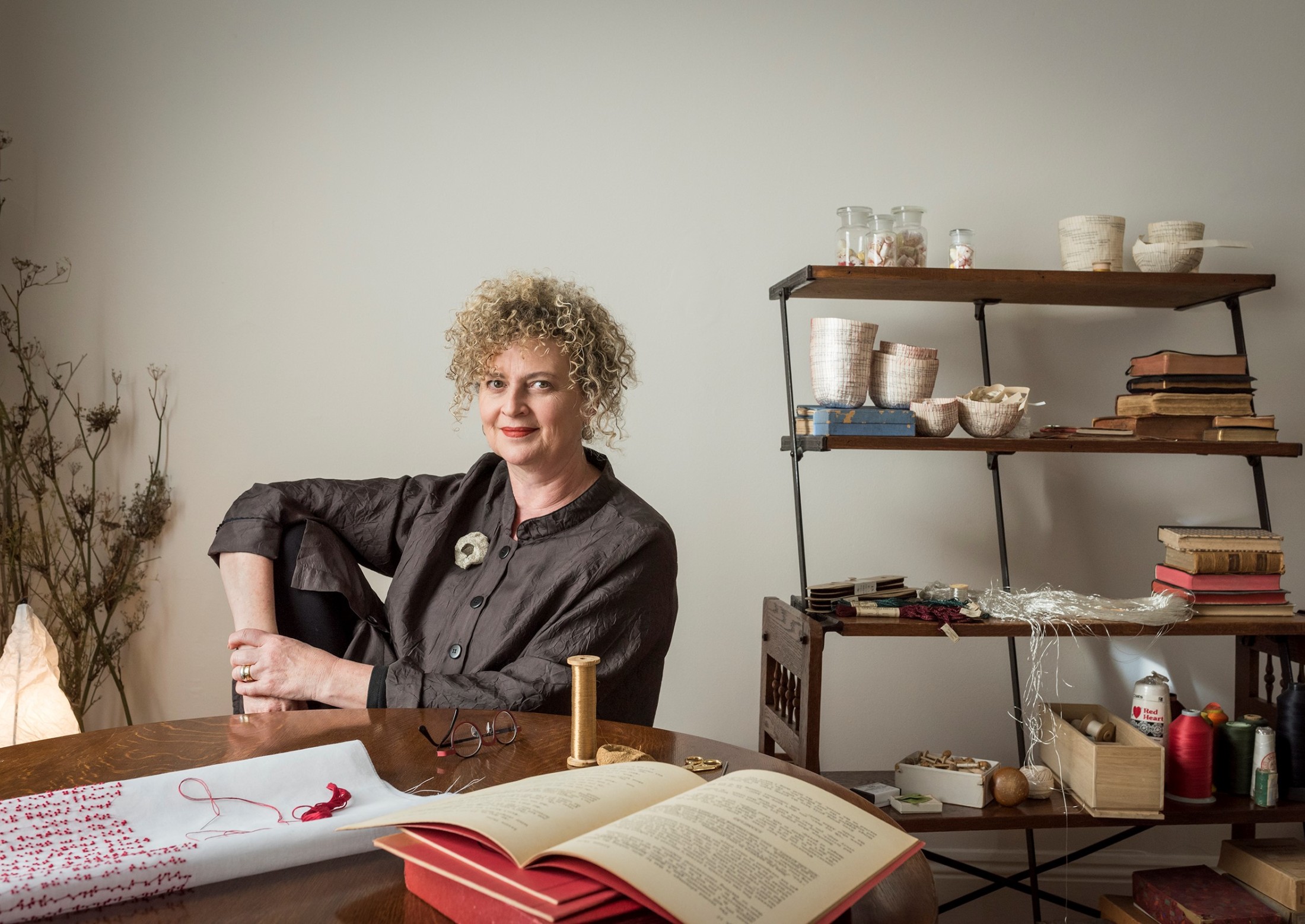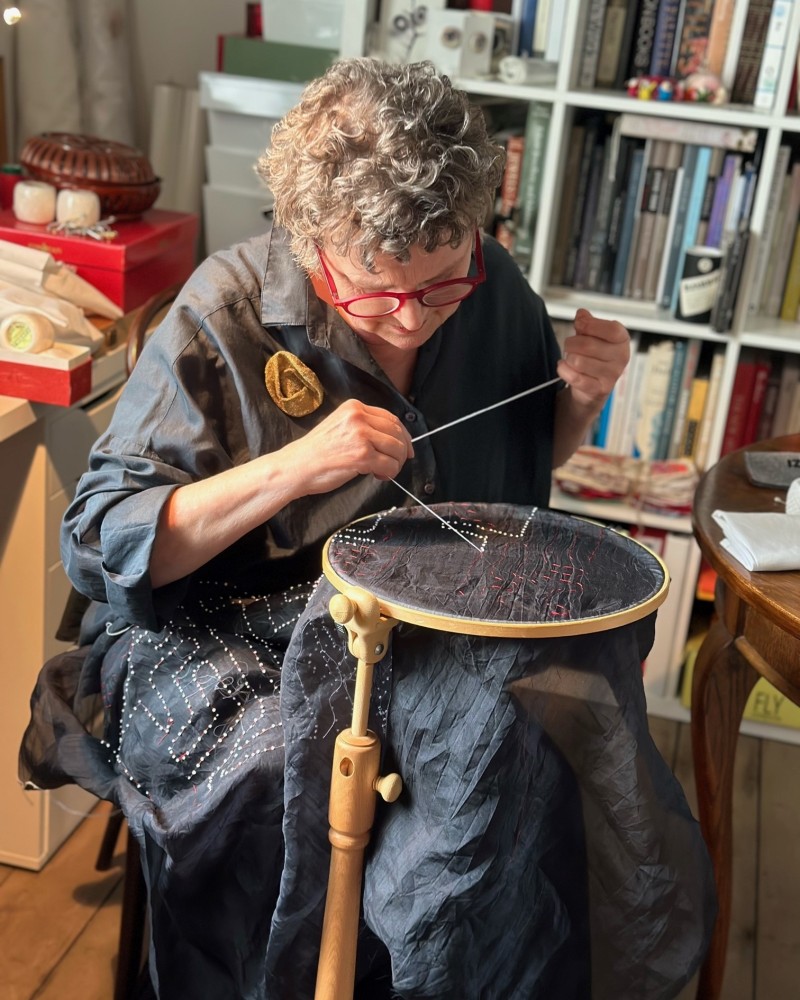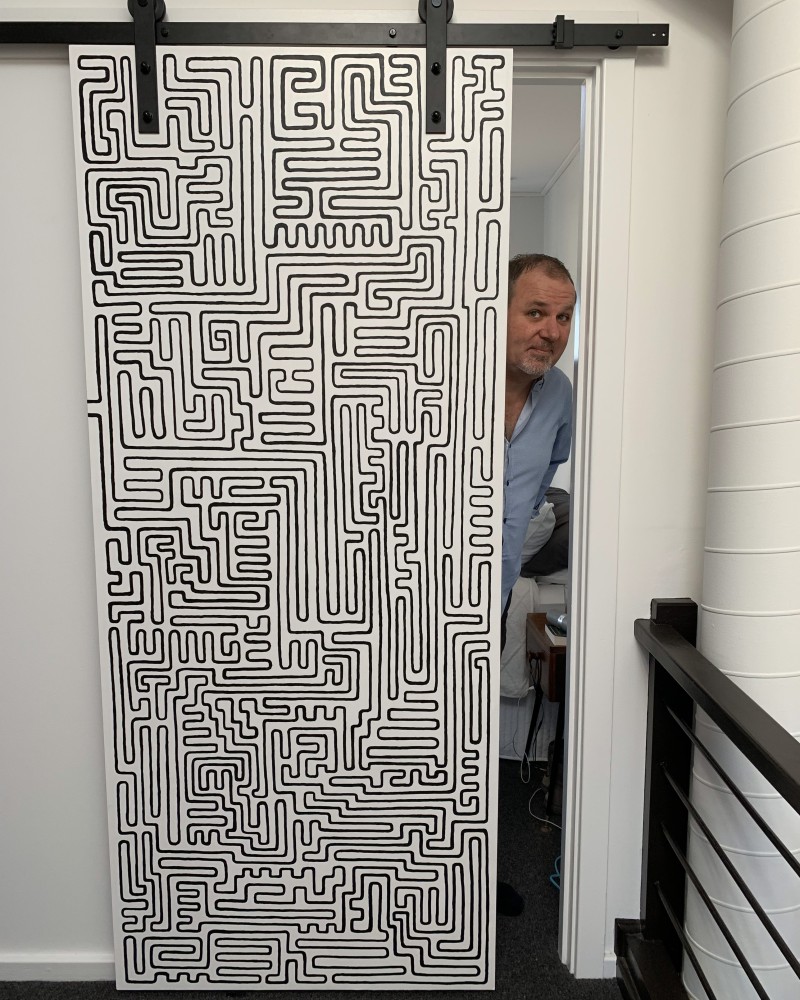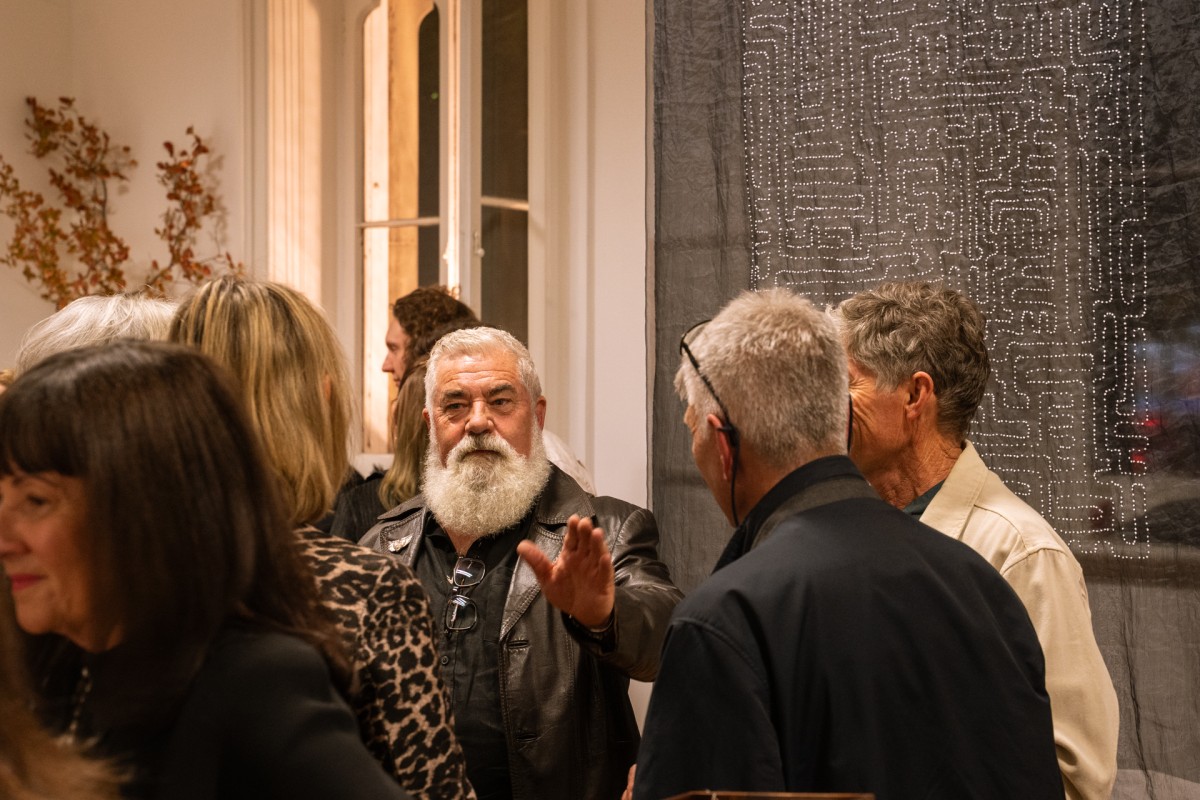
Catherine Buddle concluded her residency as our 2023 KT Legacy Recipient with a celebratory event at TCL's Adelaide studio.
On Friday, April 12th, a joyful celebration and exhibition held at TCL Adelaide culminated Catherine Buddle’s artistry as the 2023/2024 Kevin Taylor Legacy artist-in-residence.
Catherine’s exhibition, The Galaxy Within, is a response to a brief to honour Simon Brown, a long–time staff member, mentor, and friend of TCL. He sadly died of a terminal illness in early 2022, and the 2023/24 grant recognises his important contribution to landscape architecture and urban design—in particular, his seminal involvement in TCL's projects at the Adelaide Botanic Gardens.
Catherine created a textile work entitled Traces of Simon, inspired by a labyrinth artwork Simon painted on his and his wife Bec Francis’s bedroom door, and three jewellery pieces, quadrangular neckpiece, quadrangular earrings, and quadrangular brooch, which have been gifted to Bec Francis and Simon and Bec’s daughter Mackenzie.
Catherine’s Artist Statement.
Two key organic themes fascinate me and inform my work: the microscopic domain of cellular structures, and the miraculous possibilities of metamorphosis. My work seeks to embody the perfection and containment manifested through these biological phenomena — beyond the sheltering exterior of a cell wall or a cocoon, there exists the delicacy of a secret, mutable interior.
My work by nature is time-consuming, and the concentrated focus requires working in a solitary fashion. I have relished the opportunities realised through the 2023 TCL Kevin Taylor Legacy: Honouring Simon Brown to step out of my studio and work collaboratively — with Simon’s wife Bec Francis and their daughter Mackenzie Francis-Brown, Kate Cullity and TCL colleagues, and Professor Michelle Waycott and Dr Ed Biffin of the State Herbarium of South Australia, to create an intentional body of work that resonates with everyone involved.
The Legacy has bestowed me with the opportunity to extend my scientific knowledge, and to explore, experiment and focus my attention on a single project for a concentrated period.
The culmination in this exhibition contributes significantly to the development of my practice and I trust, most importantly, has been pivotal for those who didn’t know Simon to discover something about him, and for those who do, to remember.
Traces of Simon
When I visited the State Herbarium, I was drawn to the specimen sheets with small windows faced with tracing paper, enabling the plant material to be viewed from both sides. This brought to mind a quote from the TCL ‘Remembering Simon’ publication … He often used the technique of putting an image on a window so he could trace over the top more easily …
In the course of several meetings with Bec at their home, I learnt more about Simon’s attention to detail, including his love of drawing and creating imaginary maps. I was especially taken by the labyrinth he had created for their bedroom door. I decided to make a tracing, thinking I might crochet a section while waiting to collaborate with the State Herbarium team on the genetic sequencing aspect of my proposal.
It required two sessions and, when I was close to completion, the idea came to me in a flash to translate Simon’s work as an embroidered piece; sheer black silk organza suspended with a galaxy of white dots … the inverse of Simon’s creation.
Since September 2023 I have followed Simon’s hands five-fold … the initial tracing, translating the pattern to the fabric, removing the tissue, the embroidery, and an approximate measurement of the labyrinth’s total ‘meterage’ — conservatively, 160 metres and 18,500 colonial knots. Echoing Simon’s approach to his projects, it was detailed and painstaking work.
Although I never met him, I feel connected through replicating the twists and turns within Simon’s labyrinth — a metaphor for life’s journey — and translating them into his own unique galaxy.
"The cosmos is within us. We are made of star-stuff.
We are a way for the universe to know itself." CARL SAGAN
Just as astronomers look back at light from billions of years in the past to explore the origins of the Universe, genomic sequencing and analysis of the resultant data affords the Herbarium’s scientific team a forensic snapshot to trace the biological evolution of planet Earth’s plant species in the ‘Tree of Life’.
I met with Michelle and Ed to discover just a little about their phylogenetic research and biogeographical mapping of plastids, with the idea of translating some data from plants close to Simon’s heart into numerical sequences to create new work.
Aside from brushing up on my rudimentary knowledge of genetics, and attempting to come to grips with the phenomenally detailed work of the team, I was amazed to learn that plant cells have DNA not only in the nucleus, but also in the chloroplasts — the photosynthetic organelles within plant cells.
A constellation of evolutionary diversity within each cell — a galaxy within.
I was provided with complex data sets for several plant species including Acacia, Veronica and Xanthorrhoea.
Acacia pycnantha (Golden Wattle) has 26 chromosomes, and Xanthorrhoea quadrangulata (Grass Tree) which grew on Simon, Bec and Mackenzie’s Adelaide Hills property, has double the genomic material.
My concept for the jewellery work was to create a contemporary interpretation of a parure of three pieces. A parure is a set of three or more matching, and sometimes interchangeable, jewellery pieces housed in an elaborate presentation case. They came into fashion in early 19th century Europe — around the time when the lands of the Kaurna people were colonised, and the Adelaide Botanic Garden was established, with the Museum of Economic Botany created soon thereafter.
I experimented with the concept of haploid, diploid and polyploid chromosomes to devise a numerical sequence to follow: 13, 26, 39 and 52. I applied this pattern to a neckpiece, brooch and earrings with different outcomes dependent on the stitches employed. The patterning of the Herbarium data sets and schematic evolutionary trees also inspired the undulating nature of the neckpiece and earrings.
My wearable sculptures are created with fine-gauge threads, each with its own labour-intensive history. Simon often gifted jewellery to Bec and Mackenzie and I was able to view their collection. I discovered they prefer silver to gold, and this influenced the selection of rare threads from my collection to fashion the jewellery pieces: a late 19th century French silver-wrapped silk, and a vintage Japanese silk thread, wrapped with silver-foiled washi paper, as fine as hair — another galaxy within.
Every strand of the neckpiece and earrings is comprised of a number of chain stitches, that parallel my derived sequence. I crocheted four stitches into each chain, representing the base pairs in DNA: adenine (A) and thymine (T); and cytosine (C) and guanine (G). These multiple stitches cause the strand to curl upon itself — just as the double helix of DNA compresses its structure to accommodate an incredible amount of material — hundreds of thousands of base pairs — into an infinitesimal space.
Using a different stitching process, the same numerical sequence was applied to the brooch, starting with a rhomboid base, akin to the cross-section of Xanthorrhoea quadrangulata which fascinated Simon. The pattern creates twists and turns, emulating a spiral galaxy.
Each element of the parure is nestled within in its own stacking timber box — a nod to Simon’s set of nesting dolls (Evil Leaders of the World) and the bevy of boxes that house the family’s numerous collections.
I am honoured to have received the opportunity to create this work in memory of Simon, and extend my gratitude to all the creative individuals who shared their expertise and insights, as well as special family and friends for their love and support.
Bec Francis’s Response to Catherine’s Work.
When someone you love dies you are left with this gaping hole - this void - and it feels like it will never be filled - and you don’t want to forget them, so you never really want that hole to fill.
It is empty.
It is sad.
It is loss.
What I never anticipated was the fascinating blessing I would feel in the company of people from this broad community of family, friends, co-workers and colleagues - those of us who knew Simon - and the shared joy we have in remembering him - in celebrating him.
This we gain.
What has been even more incredible is seeing someone get to know Simon from the legacy of what he loved - his work, his art, his family, his story told by us - his passions for art and science and WONDER.
I had no idea what to expect when Catherine came into our lives. And now, looking at what she has achieved that word again comes to my mind: WONDER.
I like that word. WONDER.
It is very Simon.
It is gentle, thoughtful, curious, creative, caring.
It is hopeful, it is whimsy, and it doesn’t judge.
It stands on the shoulders of giants and reveals the unexpected.
WONDER is what Catherine has created.
I think it’s safe to say that Simon would not have been comfortable with this level of attention. He would’ve been amazed, overwhelmed, incredibly honoured, excited, intrigued and humbled; but not comfortable. He didn’t like being in the spotlight, but he does deserve it.
So with the greatest of thanks to Kate, to Kevin (and the wonderful relationship Simon and Kevin shared), to Alex, Damo and Enoch and all at TCL for making this possible; and with utmost awe I thank you Catherine.
And to all of you here, and especially those who have helped Mackenzie and me through the last two years; thank you.
I think now Simon would grab a glass of wine, smile that beautiful cheeky smile and encourage you to WONDER…










